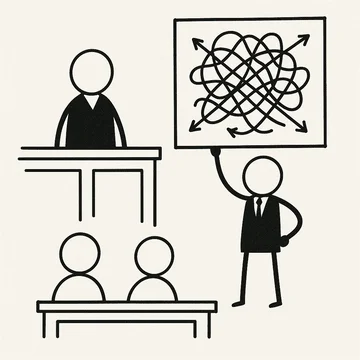
In the District of Delaware, five of our eight judges use form scheduling orders that provide a deadline for the submission of a "Technology Tutorial" around the time of claim construction.
Former Judge Stark required the parties to submit a tech tutorial in patent cases with the opening claim construction brief. Judge Stark's form order, for example, provided that:
Tutorial Describing the Technology and Matters in Issue. Unless otherwise ordered by the Court, the parties shall provide the Court, no later than the date on which their opening claim construction briefs are due, a tutorial on the technology at issue. In that regard, the parties may separately or jointly submit a DVD of not more than thirty (30) minutes. The tutorial should focus on the technology in issue and should not be used for argument. The parties may choose to file their tutorial(s) under seal, subject to any protective order in effect.
[Update 2022-03-22: Judge Burke's current form scheduling order no longer requires parties to submit a tech tutorial, and Judge Stark is now on the Federal Circuit.]
Judges Stark and Burke also provide the opportunity to object to tech tutorials:
Each party may comment, in writing (in no more than five (5) pages) on the opposing party's tutorial. Any such comment shall be filed no later than the date on which the answering claim construction briefs are due. As to the format selected, the parties should confirm the Court's technical abilities to access the information contained in the tutorial (currently best are "mpeg" or "quicktime").
Judges Noreika, Hall, and Thynge permit tutorials, but do not require them. Judge Noreika's form scheduling order, for example, recognizes that tutorials are appreciated, but does not require them:
Technology Tutorials. Although technology tutorials are not required by the Court, they are appreciated and, if any party chooses to file such a tutorial, it shall be submitted on or before the date that the Joint Claim Construction Brief is filed.
What Is a Tech Tutorial in a Patent Case?
Parties interpret "technology tutorial" in many different ways. Most often, a tech tutorial is a video of 30 minutes or less describing the background of the technology. What constitutes background varies a lot in different cases, and depends on whether you are the patentee or the accused infringer.
The format also varies. Here are some example formats people have used:
- Professionally-animated video narrated by a voice actor
- Slide presentation video narrated by the parties' expert
- Slide presentation with text on the slides to explain them
- Slide presentation with slides notes printed to PDF
- Slide presentation without text, slide notes, or narration
Most of those formats work well, and which one is most appropriate depends on the particular case and the parties' resources.
The only format I would not do, personally, is a slide presentation without an accompanying audio or text explanation. Parties sometimes submit these with a general idea that they will present them later, at the claim construction hearing. Typically, though, once the hearing comes around, the parties realize they need to devote their precious oral argument time to other things, like actually arguing their constructions.
How Often Does the Court Rely on Tech Tutorials in Opinions?
I was curious how often tutorials are explicitly mentioned by the Court in its opinions. The answer is: not all that often, with a few exceptions.
Looking at all D. Del. cases with the word "tutorial" (it's not that many), I found just 11 cases where the Court either relied substantively on or at least praised a tech tutorial. That's really not a lot in light of the thousands of summary judgment and claim construction opinions issued by the court.
Cases Where a Tutorial Helped
I found five cases where the Court relied on a party's tutorial in a helpful way for that party, and two cases where the Court specifically praised a party's tutorial for being helpful. This included one case where the Court specifically relied on the plaintiff's tutorial to deny the defendants' non-infringement SJ motion.
See Hand Held Prods. v. Amazon, Inc., C.A. No. 12-768-RGA-MPT, 2016 U.S. Dist. LEXIS 6823, at *21 (D. Del. Jan. 21, 2016) (Thynge, J.) (relying on plaintiffs' technology tutorial to deny defendant's summary judgment motion of no infringement).
Cases Where a Tutorial Hurt
BUT—I also found four cases in which a party shot themselves in the foot, and two cases where the Court specifically criticized a party's tutorial. Those four cases included a case where a plaintiff made an admission that the Court relied on in holding their patent ineligible under § 101, along with three cases where the Court relied on a parties' tutorial in rejecting their own construction.
See Intellectual Ventures I LLC v. Symantec Corp., 100 F. Supp. 3d 371, 394 (D. Del. 2015) (Stark, J.) (citing plaintiff's statement in tutorial that “[c]onceptually, [the patent's] post office is not much different than a United States Postal Service office” to hold e-mail "post office" patent ineligible under § 101).
In other words, looking only at the cases where the tech tutorial had an impact on a written opinion, the tutorials hurt the party submitting it nearly as often as it helped!
Are Expensive Video Tech Tutorials Worth It for the Parties?
Tutorials, particularly video tutorials, can be expensive. In one case, the Court noted that defendants had spent "$131,043.60 in direct non-attorney costs" for a tech tutorial and Markman slides. Intellectual Ventures I LLC v. Symantec Corp., C.A. No. 13-440-LPS, 2019 U.S. Dist. LEXIS 169043, at *10 (D. Del. Sep. 30, 2019) (Stark, J.).
Factor in attorney fees for actually drafting the tutorial, particularly if it was a multi-defendant case where the parties may have had some back-and-forth over the content, and it's easy to imagine the real cost of that tutorial could have been $150,000 or more across the cases.
That's a significant amount of money, particularly for something that may end up working against you, as in the 4 cases above where the tutorial was used against the party submitting it.
On the other hand, that amount of money could be more significant in some cases than others. And, for defendants at least, the costs can often be split across multiple defendants.
Plus, tech tutorials undoubtedly have benefits for both the parties and the Court beyond the question of whether they directly impact opinions. It is certainly in the parties' best interest for the Court to have the best possible understanding of the technology. And a slick, well-put-together presentation can leave a good impression on the Court. Those kinds of benefits are impossible to quantify.
All told, the answer depends on the circumstances of the case and the amount of resources available. But it's worth giving some thought to the costs and risks in weighing how and whether to submit a tech tutorial.
If you enjoyed this post, consider subscribing to receive free e-mail updates about new posts.





